Turks and Caicos Sharks
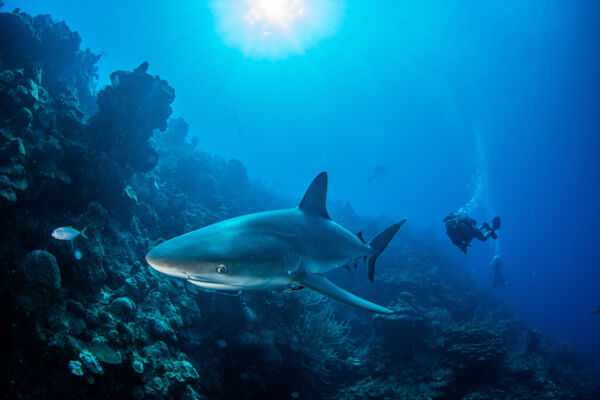
As is the case in any healthy Caribbean environment, sharks can be seen throughout the Turks and Caicos Islands. On the archipelago's extensive barrier reef, grey reef sharks are common, and in the wetlands, nurse sharks and lemon sharks (often juveniles) can be spotted. Tiger sharks, bull sharks, and hammerhead sharks are uncommon but can be seen in the islands.
A great place to see tiny sharks is the Princess Alexandra Nature Reserve off the east coast of Providenciales. At low tide, the sandbars and mangrove channels here trap lemon sharks and nurse sharks in pockets of deeper water until the tide changes.
Unfortunately, there have been several recorded shark attacks on humans in the Turks and Caicos.
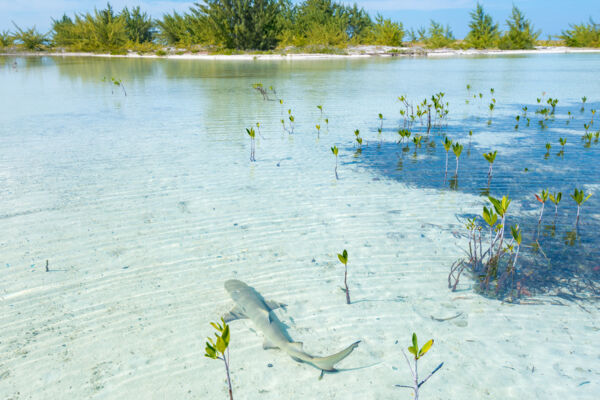
In the vast majority of cases globally, it’s thought that shark attacks on humans have been primarily caused by mistaken identity. Notably, there are far more people swimming in the Turks and Caicos today than there were in the past. It’s also possible that overfishing may be disturbing the natural marine food chain.
Sharks are apex predators (alpha predators at the top of the food chain), and have comparatively poor eyesight, so they may bite anything that remotely resembles their typical dinner. Once their prey doesn’t respond normally, they typically release their bite.
Sharks at Popular Beaches
Sharks are generally quite rare at the popular beaches of Grace Bay, the Bight Beach, Leeward Beach, and Long Bay Beach. When the occasional shark is sighted in these areas, it’s almost always a mid- to small-sized nurse shark, which is a very docile shark.
It is very rare to see any shark other than rays or nurse sharks at the popular Smith’s Reef and The Bight Reef (Coral Gardens) snorkeling sites on Providenciales.
Shark Attacks in the Turks and Caicos
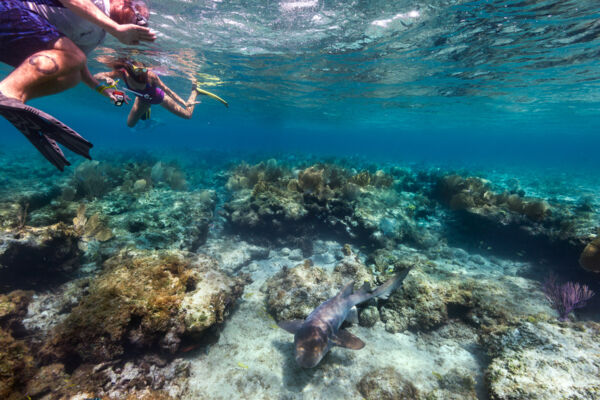
Between 2021 and 2025, four people were reported to have been attacked by sharks in the Turks and Caicos. All victims survived.
The 2025 Blue Hills Attack
On February 7, 2025, a woman was wading in hip-deep water off the eastern end of Blue Hills Beach near Da Conch Shack and Thompson's Cove Beach when she was attacked by a shark, reported to be a 6–9 foot (2–3 m) bull shark or tiger shark. The woman experienced serious injury and lost both of her hands.
The 2024 Leeward Reef Attack
On May 23, 2024, a male resident was snorkeling at Leeward Reef off the northeast coast of Providenciales when he was attacked by a shark. The snorkeler received significant trauma to his leg, resulting in amputation above the knee.
He was in a small group, snorkeling from a boat, and was in the water for less than 10 minutes before the attack occurred. Two notable facts about this attack is that it happened almost exactly a year after the 2023 incident where a snorkeler lost her foot, and that there was torrential raining and flooding in the Turks and Caicos on the day of the attack.
The 2023 Grace Bay Attack
On May 24, 2023, a 22-year-old visitor was attacked by a shark, resulting in her foot being bitten off. The tourist was snorkeling near the barrier reef off Grace Bay.
The 2021 Bight Reef Attack
On September 3, 2021, a male visitor was reportedly bitten on the wrist by a 7-foot (2.1 m) lemon shark or tiger shark in shallow water near the Bight Reef (Coral Gardens) snorkeling site. The shark was afterward filmed swimming east in the shallow water directly off Grace Bay Beach.
The 2011 Mudjin Harbour Attack
In what was likely a case of mistaken identity, a snorkeler was struck by an unknown type of shark off of Dragon Cay at Mudjin Harbour, Middle Caicos.
This attack occurred close to the rocks, where breaking waves and bubbles in the water reduced visibility to about a foot. The victim, a 28-year-old male visitor, was snorkeling in shallow water quite close to the rock and received a quick strike and laceration to his shoulder.
The tooth pattern suggests that the shark was about 5 to 6 feet (1.5 to 1.9 m) and may have been a grey reef shark. The victim received local medical attention and 18 stitches.
The 2011 Caicos Banks Spearfishing Attack
This incident happened between Providenciales and French Cay. A local 35-year-old fisherman was spearfishing (which is illegal in the Turks and Caicos and results in blood in the water and thrashing fish) in the relatively shallow waters of the Caicos Banks.
The man received a bite from a 5-foot (1.5 m) shark to his lower right leg. He was treated locally.
The 2002 French Cay Snorkeling Incident
In 2002, a group of experienced dive photographers from a large regional liveaboard boat was snorkeling near French Cay in the southern Caicos Banks after the morning’s first dive.
The victim, a 41-year-old female visitor, was in the water taking photos. She was approached quite closely by a 6–7 foot (2 m) grey reef shark, which brushed against her. As the shark began to turn away, it made a quick strike to the victim’s shoulder and upper arm. This resulted in a very serious injury and critical blood loss.
Fortunately for the victim, a surgeon, physician, and ICU nurse were part of the dive group, and they had a decent selection of medical equipment and supplies. They were able to stop most of the bleeding in time.
After being transported by a Royal Turks and Caicos Islands Police Force vessel to Providenciales, the victim was airlifted to Florida for emergency surgery.
Barracuda
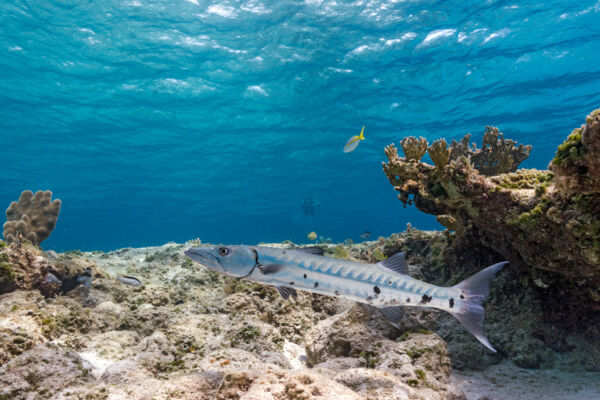
These toothy hunters are a common sight in most marine environments in the Turks and Caicos. Capable of swimming at lightning-fast speeds, barracuda thrive on a diet of small fish.
Although they give off quite a menacing appearance, they should not be considered dangerous. The very few barracuda attacks that have happened have typically followed the same scenario: a quick strike at something shiny (usually in poor visibility) followed by a rapid retreat after discovering that they didn’t bite a fish.
Barracuda are very curious fish. Although easily spooked, they will often follow snorkelers and divers.
In many cases, barracuda likely view humans as larger predators and are hoping to get scraps of a feast.
Lionfish
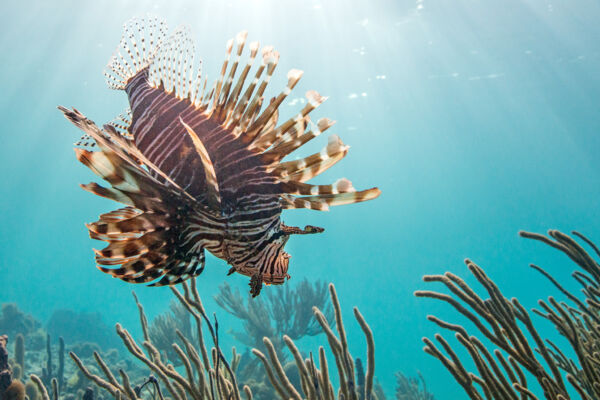
Any page covering dangerous Caribbean marine animals should mention lionfish. This invasive species from southern Asia is found in the warmer Atlantic waters.
While not aggressive, this fish has spines on its back that are capable of giving nasty stings, which in very rare cases can cause temporary paralysis.
Lionfish are usually found hiding close to the reef, and are not common to the open water of the country’s popular beaches. You’ll only likely encounter them if you touch or walk on a reef.
Reducing the Risk of a Shark Attack
You’re more likely to be in a serious car accident than be a victim of a shark attack in the Turks and Caicos Islands. To reduce your risk of a shark attack, consider the following:
- Sharks tend to be more active in the evening and early morning. Consider avoiding swimming at these times, especially in areas of poor visibility.
- Don’t wear shiny or flashy jewelry. This can appear to sharks and barracuda (which have poor eyesight) to be small silver fish and can (potentially) provoke an attack.
- There have been no reported attacks in these areas, however, sharks are regularly spotted off the cliffs at West Harbour Bluff and in Leeward Channel between Providenciales and Mangrove Cay.
- Consider avoiding swimming in areas where chumming takes place or where fish and conch are cleaned and discarded in the waters nearby.






